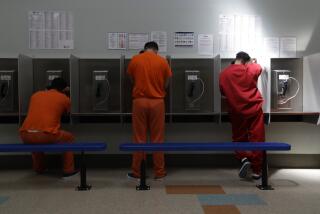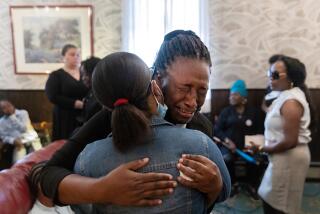From mislabeling to miscommunication, there were plenty of misses in coronavirus snafu

- Share via
SAN DIEGO — A long chain of missed opportunities led to an infected coronavirus patient mistakenly being discharged from a San Diego hospital Sunday and then returned Monday.
The U.S. Centers for Disease Control and Prevention and UC San Diego Health on Tuesday provided additional information on how the snafu happened. The update comes as concern continues to grow about an outbreak that started in China and has now produced a positive case in San Diego County after more than 200 evacuees arrived at Marine Corps Air Station Miramar to wait out a 14-day government-mandated quarantine.
Both organizations said Tuesday that the mix-up started with simple mislabeling when local hospital personnel collected blood samples last week from three of four evacuees who showed possible coronavirus symptoms.
The university said in a statement that its workers labeled the blood draws using a standard system of pseudonyms designed to protect privacy, adding that different requirements “were not shared with our institution.”
Subscribe to San Diego News Fix wherever you get your podcasts
The labels were apparently good enough that local CDC personnel missed an opportunity to correct them before sending them off for testing at the government agency’s main public health lab in Atlanta.
Lab personnel, according to a CDC statement, set aside the three samples after receiving them but missed an opportunity to let their colleagues in San Diego know they had done so.
Finally, when San Diego CDC personnel called to get the test results, Atlanta lab personnel missed the fact that the samples for those three patients had been set aside due to the labeling incongruity, instead giving San Diego CDC officials negative results for three different patients.
Added together, it was a long enough chain of misses to make the CDC comfortable sending the hospitalized patients back to Miramar to complete their quarantines.
Eventually, said Tom Skinner, the CDC’s information officer on the ground in San Diego, the three set-aside samples were rediscovered and tested, revealing that one of the four evacuees initially said to be in the clear was actually infected.
All four of the returned evacuees, Skinner said, were wearing masks during their trips back to the base Sunday. CDC employees in San Diego were aware of the mix-up Sunday, he said, and asked those who received incorrect results to stay in their rooms until the correct results were available. The exact timing and occurrences on base — how long the infected evacuee was present and everything he or she did while there — has not been made public.
The CDC, Skinner said, has “done preliminary contact investigation” and continues to investigate to “see if anyone may have had high risk exposure.” Any time a person tests positive for a communicable disease such as novel coronavirus, public health departments work to interview anyone they came in contact with, isolating those who might have become infected. The CDC also plans to deploy additional lab staff to the field to make sure similar mix-ups don’t occur, Skinner said.
UC San Diego said it has now reached a new level of label literacy with its federal counterpart.
“We have since worked closely with the CDC to protect privacy while insuring that labeling matches at all facilities,” the university statement said.
At present, eight of the more than 200 evacuees under quarantine at Marine Corps Air Station Miramar have shown symptoms suggesting that they may be infected, but only one has tested positive. A man and his daughter sent to Rady Children’s Hospital in San Diego last week tested negative Friday. Results for a patient sent to a UC San Diego hospital Monday have not been shared publicly. Results are still outstanding for a child sent to Rady last week.
Sisson writes for the San Diego Union Tribune.
More to Read
Sign up for Essential California
The most important California stories and recommendations in your inbox every morning.
You may occasionally receive promotional content from the Los Angeles Times.












